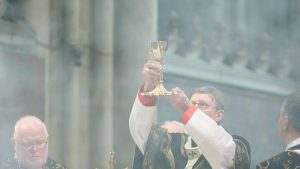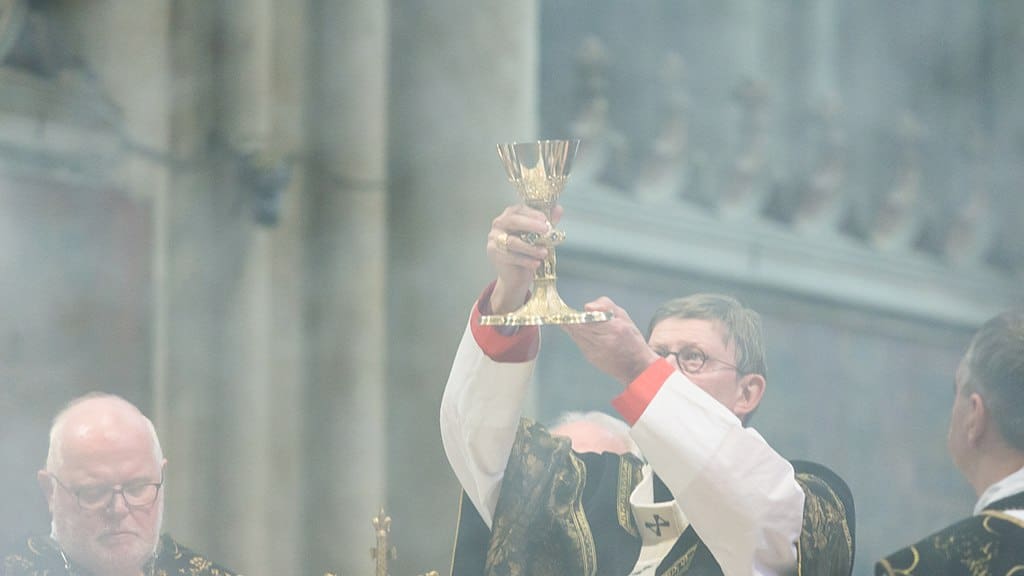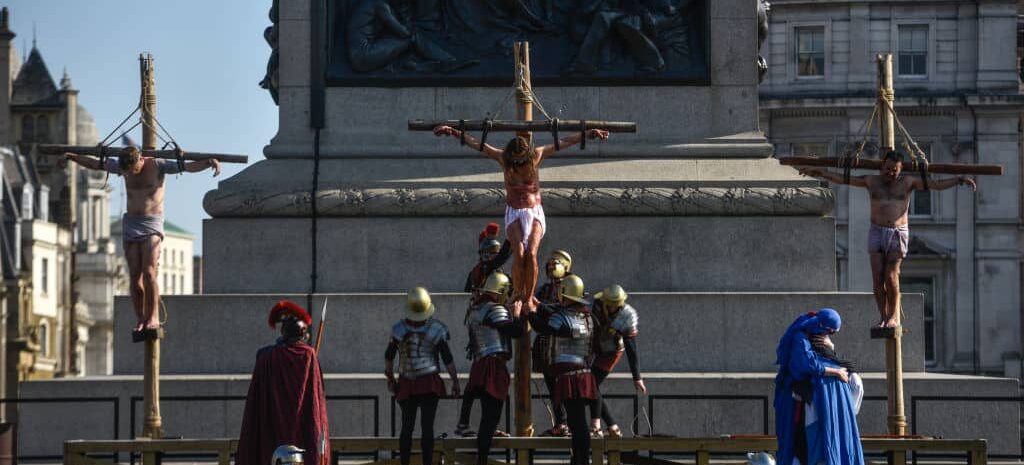While the Missal of Paul VI greatly simplified the gestures associated with the Eucharistic Prayer, the traditional practice of the Roman Rite can still inform much of the manner in which the gestures which remain are carried out, as foreseen in no. 42 of the General Instruction of the Roman Missal. In addition, the revised missal often gives no indications at all about a range of gestures which, over the centuries, had become associated with the celebration of the Canon of the Mass (Eucharistic Prayer I). These too can help enrich the celebration of the Eucharist according to the postconiliar missal. It is perhaps best to begin in this post with the gestures and postures which are common to the celebration of all the Eucharistic Prayers before indicating, in the next post, those which are specific to Eucharistic Prayer I.
Following the prayer over the gifts, the celebrant will find the preface selected by using his left hand since the missal is historically placed to the left of the corporal at an angle. It is best to find the preface desired before actually beginning the preface dialogue, “The Lord be with you.” At the same time, the right hand is placed flat on the altar outside the corporal. This was a consistent principle in the historical celebration of the Roman Rite. Whenever a hand or both hands were placed on the altar prior to the consecration, they were placed flat on the altar outside the corporal. Whenever the hand or hands were on the altar after the consecration had taken place, they were placed on the corporal. While the revised missal makes no mention of this practice, it seems a worthwhile principle to foster, in continuity with the traditional practice.
find the preface selected by using his left hand since the missal is historically placed to the left of the corporal at an angle. It is best to find the preface desired before actually beginning the preface dialogue, “The Lord be with you.” At the same time, the right hand is placed flat on the altar outside the corporal. This was a consistent principle in the historical celebration of the Roman Rite. Whenever a hand or both hands were placed on the altar prior to the consecration, they were placed flat on the altar outside the corporal. Whenever the hand or hands were on the altar after the consecration had taken place, they were placed on the corporal. While the revised missal makes no mention of this practice, it seems a worthwhile principle to foster, in continuity with the traditional practice.
When beginning the preface dialogue (V/. The Lord be with you. R/. And with your spirit. V/. Lift up your hearts. etc.), the celebrant extends his hands toward the assembly and looks at the assembly, just as he does at the beginning of Mass itself. (When facing liturgical east, the traditional practice is for the celebrant to remain facing east throughout the entire preface dialogue since he will need the missal before his eyes for the three lines of the dialogue and for the musical notation if these dialogues are sung. (See Peter Elliot, Ceremonies of the Modern Roman Rite, Ignatius Press, 1995, 282, n.43.)) The celebrant continues to look at the assembly through the next two dialogues. He then raises his hands at the second invitation, “Lift up your hearts.” He then lowers his hands to the orans position, for “Let us give thanks to the Lord our God.”
The orans position of the hands can be expressed in a variety of ways. In general, it seems best to keep the fingers of the hand together and allow the palm to fall into an open position which seems natural and not tense. The hands can be kept in a position slightly before the shoulders, with the elbows near the body (See Elliott, Ceremonies, 70). The celebrant should avoid moving the hands up and down while reading. One hand never remains raised when the other hand is occupied. In that case, the free hand always rests on the altar.
The celebrant keeps his hands in the orans position as he begins the preface. If the name of Jesus, Mary, or the saint commemorated on that day is mentioned during the preface, he bows his head. Only at the conclusion of the preface, does he eventually join his hands as he sings the Sanctus (“Holy, Holy, Holy”) with the assembly. The celebrant may wish to keep his eyes downcast in a recollected way during the singing.
The Sanctus concluded, the celebrant extends his hands once again in the orans position, and continues with the Eucharistic prayer. Just prior to the epiclesis, if the chalice is covered with a pall, the celebrant places his left hand at the base and removes the pall with his right hand, placing it near the top right edge of the corporal. Similarly, covers to the ciboria are removed at this point with the right hand, the fingers of the left hand steadying the base of each ciborium.
At the epiclesis, the celebrant joins his hands together first, then opens them flat, keeping the right thumb locked over the left thumb. He extends both hands respectfully over the gifts to be consecrated, neither immediately over them nor too high, with the elbows slightly bent in a relaxed position (See P. Elliot, Ceremonies, 109). In all the prayers, except Eucharistic Prayer I, the celebrant makes the sign of the cross at the epiclesis. He begins with both hands joined, then makes the sign of the cross with his right hand over the gifts, his left hand resting flat on the altar outside the corporal. The right hand—with fingers joined—is held perpendicular to the table of the altar, and the sign of the cross is made over the gifts, from the top of the corporal to the principal host, and laterally from one edge of the corporal to the other. The sign of the cross should not extend beyond the edges of the corporal itself and is made without lowering the hand or the fingers, but keeping them in the same plane at all times (See André Mutel and Peter Freeman, Cérémonies de la Sainte Messe, Éditions Artège, 2012, 133). As the celebrant concludes the epiclesis, he draws the hands together and toward himself. They remain joined until he is about to take the elements in his hands.
When the celebrant is about to take up the host, he might wipe his thumb and index finger on the corporal by drawing them across the corporal from the center to the edges once (See P. Elliott, Ceremonies, 301). He holds the host with the thumb and index finger of both hands, keeping the other fingers of both hands extended and joined to each other. He holds the host raised slightly over the altar and bows slightly toward it to recite the words of consecration. (Historically, at this point, the priest has always directed his gaze toward the host while saying the words of institution.) The celebrant then stands upright and raises the consecrated host in both hands directly over the corporal at eye level or slightly higher in order to show it to the people. (When facing liturgical east, the celebrant will have to raise the Host above the height of his head so that it can be seen in order to be adored. The celebrant does not turn around in order to show the Host to the assembly at this point.) Rather than moving his body or his feet from side to side when showing the consecrated host to the assembly, the celebrant holds the Blessed Sacrament motionless for a time. He joins the assembly in directing his gaze toward the elevated host. This period of adoration is not meant to be extended disproportionately. The celebrant then lowers the consecrated host directly onto the paten. He may replace the covers to the ciboria at this point. Then, he places his hands flat inside the corporal and genuflects without bowing his head.
The celebrant then takes up the chalice in both hands, the fingers of the right hand grasping the node of the chalice and the left hand holds the base of the chalice. He holds the chalice slightly raised over the altar and bows slightly toward it as he says the words of consecration. According to the traditional practice, he directs his gaze toward the wine being consecrated, at least for part of the words of institution. Standing upright, he then immediately raises the chalice with both hands over the corporal and shows the chalice to the people, holding the cup at eye level or slightly higher. Like those in the assembly, the celebrant too directs his eyes toward the chalice. (Again, if the celebrant has been facing liturgical east, he raises the chalice above his head without turning around to face the assembly.) After a moment, he lowers the chalice directly onto the corporal. At this time, the celebrant might replace the pall on the chalice with the right hand, placing his left hand on the base of the chalice to steady it. The celebrant then places both hands flat within the corporal and genuflects, keeping his head erect. Upon rising, with hands joined, he looks at the people and says, “The mystery of faith.” (If the celebrant is facing liturgical east, he does not turn toward the assembly to say or sing this.) The celebrant then keeps his hands joined while singing the memorial acclamation.
The celebrant then extends his hands to continue the rest of the Eucharistic prayer. If there are concelebrants who will have a spoken part of the Eucharistic prayer, the celebrant joins his hands before him in a prayerful position while they speak their parts. Just before the doxology, the celebrant may once again uncover the chalice in the same manner described above. If there is no deacon, the celebrant takes the chalice in his right hand at the node and the paten in his left hand to elevate both. The elements are elevated above eye level since the doxology is addressed to God the Father, not to the assembly. Once the assembly has responded “Amen,” the elements are then placed directly and reverently back on the altar in the same position they occupied prior to the elevation. If a pall is used, the celebrant places it once again on the chalice in the manner described above.
In the next post, this series will examine the gestures specific to Eucharistic Prayer I, the Roman Canon, since it has a more complex form than the other Eucharistic prayers in use.



